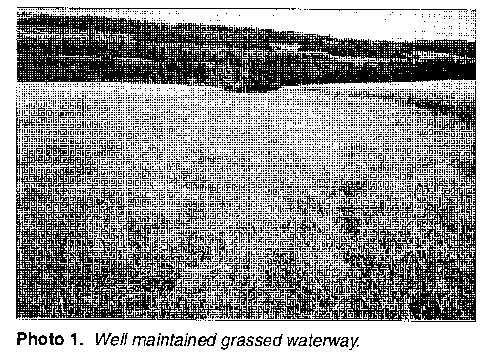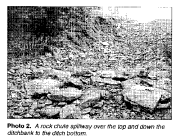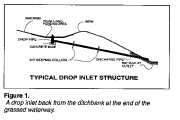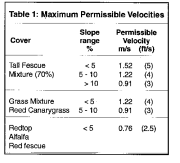Prevention method to reduce soil erosion
Soil Erosion
Soil erosion is the process of detachment and movement of soil particles. The degree of erosion is dependant on the soil's water infiltration rate, water holding capacity, structural stability and the intensity and duration of precipitation. The soil may be depleted of it's productivity as surface runoff contains soil particles, nutrients and organic matter. This surface runoff may cause rill erosion and more severe gully erosion if left without proper control measures. Grassed waterways are used as a "Best Management Practice" to enhance sediment control. They filter the sediment out of the runoff keeping it on the field and out of watercourses.
Grassed waterways may be used alone to safely discharge surface runoff or in combination with diversion terraces and other structures as part of an erosion control system. Waterways are often constructed in natural depressions across fields where water collects and flows to an outlet. Natural or constructed waterways are broad and shallow vegetated channels (Photo 1.) that convey flows across farmland toward a suitable outlet. Simple erosion control outlets such as filter strips can also reduce soil erosion.

A grassed waterway is designed to safely dispose of the predicted runoff from the worst 24 hour duration storm in 10 years. If the outlets were located within an urban / residential area, a one in 25 year frequency - 24 hour duration storm is used. Grassed waterways usually discharge into surface drains such as wooded areas or watercourses.

It ' is critical to design and construct non erosive outlets. If a waterway outlet is discharged into an open ditch, a stream or watercourse, various measures would have to be taken to dissipate the flow energy and protect the outlet against erosion. Such measures include:
- A rock chute as indicated in photo 2 or:
- A drop inlet structure as indicated in figure 1.

Grassed waterways are beneficial on cultivated areas where concentrated surface runoff occurs. When the design discharge of the grassed waterway is greater than 2.8 m 3 Is (100 cfs) and/or the design velocity is greater than the permissible velocity, the waterway shall be designed with a stone centre or in combination with other special conservation structures. Also permanent nondegradable erosion control mats, or other systems can be used as required to safely discharge the peak flow. Typical maximum permissible velocities are presented in table 1.

Shape of Grassed Waterways
A grassed waterway cross-section is generally parabolic (figure 2.) to reduce the risk of meandering. Areas where steep slopes are prevalent may require trapezoidal cross sections which are more efficient for larger runoff discharges. While the trapezoidal is more difficult to construct and maintain, it is very effective hydraulically. The recommended side slopes would be 6:1 to 8:1 to improve waterway crossing and farmability. This slope slows the velocity and reduces the soil erodibility.

If waterways are too long the water velocity may increase substantially due to the grade variation. Rock lining the channel with rip rap or rock drop structures can dissipate energy, so flow is maintained at nonerosive velocities. If the waterway is to be crossed frequently, by farm equipment, subsurface or tile drainage may also be required. Tiles would be offset from the centre one-quarter of the width and run the length of one or both sides. The tile drain outlets should be offset from the waterway outlet.
Size of Grassed Waterways
The size of the waterway will vary according to the amount of runoff it must transport and if it is used as an outlet for a companion conservation structure. The minimum grassed waterway depth shall be 0.3m (1.0 ft). The depth should be increased to properly outlet diversion terraces and/or other structures that are designed to discharge into the grassed waterway and permit adequate row drainage. The minimum width shall be greater than 8m (26 ft) to improve farmability, such as seeding, mowing, and machine crossing. The maximum width is usually less than 20m (66 ft) except where other suitable outlet locations or methods cannot be found.
Time of construction, seeding and initial protection
Grassed waterways must be constructed and seeded prior to the end of August to establish adequate vegetative cover to resist the erosive flows of fall and spring runoff. If constructed in the fall netting is strongly recommended to limit spring damage. The construction of the waterway should begin when it can be completed in a relatively short period of time and when the soil is workable, not too wet. The timing should create the least amount of interference with adjacent crops, as well waterways should be constructed perpendicular to the direction of cultivation to avoid herbicide damage to the vegetative cover in the waterway.
Waterways should be seeded with a grass mix that spreads by rhizomes. A recommended mix for the New Brunswick potato belt soils is 70% tall fescue, 20% creeping red fescue, and 10% red top. This grass mix has been successful when broadcast seeded at a rate of 55 kg/ha (50 lb./acre). In most cases lime will be necessary to instease the pH of the soil, and an adequate fertilizer should be added. Other mixes may be adopted in poorly drained soils, such as a Reed canary grass and red top mix. To provide quick vegetative cover it is recommended to under seed the mix with a cereal. If seeding is done before the end of July use a spring cereal, otherwise use a winter cereal. The seeding rate should be 70 kg/ha (60 lb./acre). The spreading of straw mulch over the seeded waterway can provide protection against untimely runoff events.
Erosion control mats are becoming more and more popular and can provide temporary erosion protection during the establishment of vegetative cover. They are very effective in maintaining a waterway in situations where heavy rainfalls are encountered before the seed has had a chance to develop. The mats reduce erosion problems by significantly reducing the erosive forces of rainfall and runoff on the soil surface while enhancing seed germination and vegetative cover. There are several types of matting available such as biodegradable and non biodegradable mats consisting of such materials as nylon, coconut fiber, straw mulch, jute, etc.
Construction and maintenance
Recommended equipment for the construction of waterways include: road graders, land levellers, dump trucks, and bulldozers. Farm tillage equipment may be used in the final smoothing operation and seedbed preparation. When preparing the water way for seeding do not till up and down along its length. This may lead to the development of rills and decrease the waterway's stability.
Benefits of Grassed Waterways
There is nothing more wasteful than a raw gully dividing productive farmland. Grassed waterways are part of the Best Management Practices for Sediment control. They improve the productive value of farmland while taking up minimal space and they are,an environmentally sound practice.
Recommended Construction Procedures
- Grassed waterways designed and constructed as part of a system to control water runoff, requires the written permission of affected downstream or adjacent landowners, or the Department of Transportation if road ditches are used.
- A Watercourse Alteration Permit may be required for waterways constructed such that the outlet is directed into a natural watercourse, such as a lake, river, or stream.
- All trees, brush, obstructions and other material should be removed from the site and disposed of in a manner, consistent with environmental regulations and the proper functioning of the waterway.
- The waterway should be excavated or shaped to the grades and dimensions according to the design plan and the survey layout. They should also be free of bank projections or other irregularities which will impede normal flow.
- The topsoil should be removed from the excavation areas and be stockpiled. A minimum depth of 15 cm of this topsoil should be replaced when the final grading takes place. This is done to promote vegetative growth.
- Any fill should be compacted or field rocks be used to prevent excessive/unequal settlement that would result in damage to the waterway.
- Any excessive subsoil that was removed during waterway construction should be used for land forming, in adjacent fields to improve row drainage, access road construction and/or stockpiled in an unused area outside of the waterway.
- Grassed waterways should be properly limed, fertilized and seeded with the recommended conservation grass mixture and maintained with a permanent weed free sod cover and should be mowed twice a year to help thicken the sod.
- All construction operations are to be performed as required to reduce soil erosion. Construction should be done when appropriate seeding is possible to protect against fall and spring runoff.
- Erosion control mats should be used in place of temporary ditches to encourage the proper establishment of vegetative cover in the waterway. The width of the mat installed should be equal to the width of the waterway required to safely discharge a 5 year - 24 hour storm.
- Grassed waterways should not be used as travel lanes for either cattle or farm machinery. Any small tracking that develops can turn into a gully and destroy the waterway.
- The importance of the design and construction of non erosive outlets cannot be stressed enough. The outlets may be protected through the use of rip rap or other energy dissipaters (Photo 2).
- Routine maintenance should be done annually to repair any small rills with appropriate patching and seeding before the waterway becomes damaged from concentrated flows.
